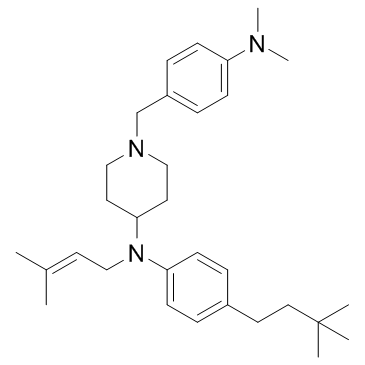N-type calcium channel blocker-1
Modify Date: 2025-08-25 20:53:07

N-type calcium channel blocker-1 structure
|
Common Name | N-type calcium channel blocker-1 | ||
|---|---|---|---|---|
| CAS Number | 241499-17-2 | Molecular Weight | 461.73 | |
| Density | N/A | Boiling Point | N/A | |
| Molecular Formula | C31H47N3 | Melting Point | N/A | |
| MSDS | N/A | Flash Point | N/A | |
Use of N-type calcium channel blocker-1N-type calcium channel blocker-1 is an orally active analgesic agent which shows high affinity to functionally block N-type calcium channels with an IC50 of 0.7 μM in the IMR32 assay. |
| Name | N-type calcium channel blocker-1 |
|---|
| Description | N-type calcium channel blocker-1 is an orally active analgesic agent which shows high affinity to functionally block N-type calcium channels with an IC50 of 0.7 μM in the IMR32 assay. |
|---|---|
| Related Catalog | |
| Target |
IC50: 0.7 μM (N-type calcium channels)[1] |
| In Vitro | N-type calcium channel blocker-1 shows good activities in the IMR32 assay (IC50=0.7 μM). N-type calcium channel blocker-1 is the most orally active N-type calcium channel blocker for analgesia found in a series of compounds[1]. |
| In Vivo | N-type calcium channel blocker-1 shows good activities in the acetic acid anti-writhing model (ED50=4 mg/kg, iv). N-type calcium channel blocker-1 exhibits oral activity (ED50=12 mg/kg, po). A time course study of N-type calcium channel blocker-1 in the anti-writhing model indicates that the CF-1 mice have maximal effect at 120 min after oral dosing at 60 mg/kg. Further evaluation of N-type calcium channel blocker-1 demonstrates several important and advantageous features: the pharmacokinetic profile of N-type calcium channel blocker-1 is improved (Versus of 5.9 L/kg and CL of 26 mL/min/kg) and the logPn of 26 is favorable for CNS agent (logPn measured to be 3.20)[1]. |
| Kinase Assay | N-type calcium channel blocker-1 is dissolved and diluted in DMSO. Different concentrations of the test compounds (N-type calcium channel blocker-1, et al.) are added to assay buffer containing approximately 3×106 loaded cells with 5 mM nitrendipine added to block l-type calcium channels. Samples are incubated for 10 min for then emission signals at 400 and 490 nm are acquired from each cuvette at 30°C for 50 s. At 20 s after the start of reading, cells are depolarized by the addition of a high K+ solution. Drug effects are expressed as a percentage of the amplitude of the K+- evoked change in intracellular calcium in drug treated compared to control experiments. PD-15130714 is run in parallel as a standard in each assay to compare the relative potencies determined. IC50 values of test compounds are calculated by fitting a four-parameter logistic function to the data using the least squares method[1]. |
| Animal Admin | Rats[1] Three Wistar rats receive a 5 mg/kg bolus intravenous dose of each compound (N-type calcium channel blocker-1, et al.) as a solution and serial plasma samples are collected at various times up to 24 hr postdose. Plasma samples are analyzed using direct protein precipitation with acetonitrile and the compound is quantitated by SciexLC/MS/MS system. A Betasil phenyl column (2.1 mm 12 cm) is used with a mobile phase of acetonitrile:0.1% acetic acid (70:30, v/v)[1]. Mice[1] Male, CF-1 mice (26 and 30 g) are given a single, intraperitoneal injection of 0.6% acetic acid. This injection evoked abdominal constrictions, defined as discrete episodes of torso and hind limb stretching with or without neck arching, are counted and recorded for 5 min, beginning 7 min after acetic acid injection. The mice are individually housed in Nalgene cages and allowed to move freely during the experimental period (12 min). Animals are sacrificed by CO2 asphyxiation immediately after the 5-min observation period. Test compounds (N-type calcium channel blocker-1, et al.) are administered by intravenous or oral routes approximately 10 min prior to administering the acetic acid. The dose response relationship for antinociceptive effects during the acetic acid writhing test are assessed by plotting the incidence of abdominal constrictions against dose of the test compound. ED50 values are calculated using a four parameter logistic function[1]. |
| References |
| Molecular Formula | C31H47N3 |
|---|---|
| Molecular Weight | 461.73 |
| Storage condition | 2-8℃ |